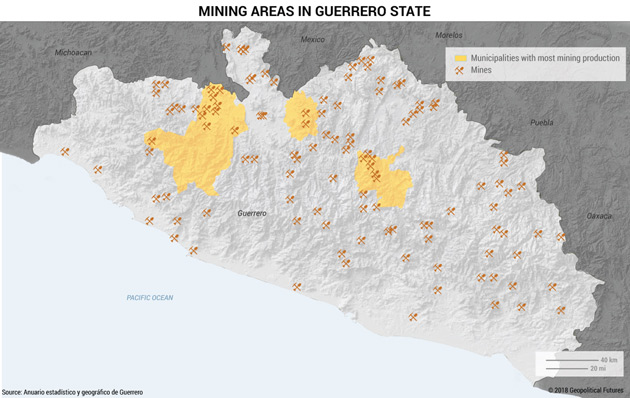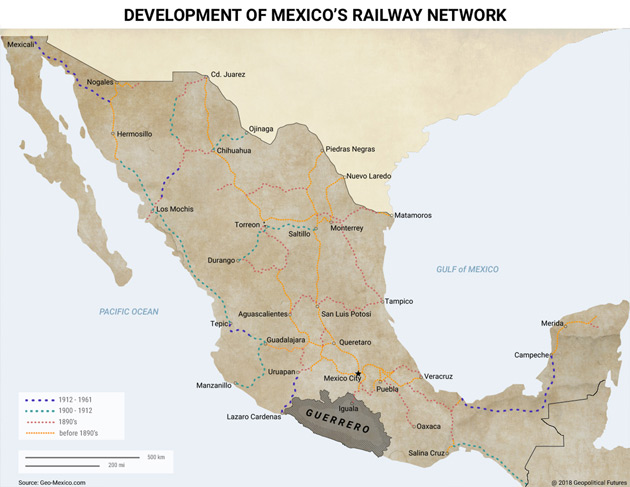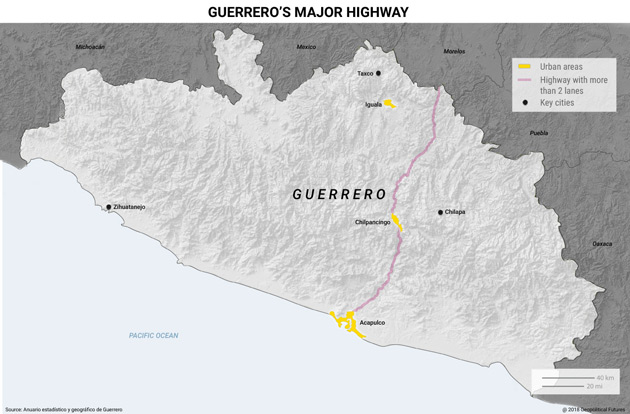| -- | April 30, 2018 An Overlooked and Underdeveloped Region in Southern Mexico By George Friedman and Allison Fedirka On the whole, Mexico is a fairly prosperous country. It ranks 15th in the world in terms of gross domestic product and is classified as an upper middle-income country by the World Bank. But its wealth is not distributed evenly, and Guerrero state is a perfect example of the poverty and underdevelopment that exists in many parts of the country. Located on the Pacific coast and 120 miles (200 kilometers) southwest of Mexico City, Guerrero state had the most homicides of any state in Mexico last year. There are at least six major drug trafficking organizations operating in the state and competing for territory. Some areas of Guerrera (most notably the Chilpancingo-Chilapa corridor) have almost no government presence and are controlled mainly by drug cartels that offer to “protect” local residents in exchange for their labor in poppy fields. Though this can be attributed partly to geography—the state is mountainous and therefore hard to secure from the outside—it’s also due to the fact that the state was not seen as a priority during various points in Mexico’s history. Left Out of the Infrastructure Boom Why have these conditions developed in Guerrero, while other parts of the country have prospered? One reason is the lack of infrastructure. Mexico experienced a wave of infrastructure development after the second French intervention in the 1870s, and again during the early years of the Porfirio Diaz government in the 1880s. In 1860, Mexico had only 150 miles of disjointed railway, but just 24 years later, this number grew to 7,500 miles. Initially, officials wanted to construct a rail line linking Veracruz (on the east coast) with Acapulco (a port city in Guerrero) via Mexico City. But ultimately, they did not follow through with this plan, and Guerrero was largely left out of the infrastructure boom—a fact that has limited the state’s development ever since. Guerrero’s mountainous terrain makes infrastructure development costly. Heavy rains during summer months also make construction harder and increase the cost of maintenance for existing tracks. At the start of the railway boom, private companies and investors from the US, UK, and elsewhere funded infrastructure projects, choosing which projects to invest in based on business interests. In Guerrero, these interests mainly related to mining because the northern part of the state is rich in minerals and metal deposits. This provided enough financial incentive to construct a railway from Mexico City to Iguala, a city located in the mining region and relatively close to Mexico’s capital. 
Source: Geopolitical Futures (Click to enlarge) But when metal prices fell at the end of the 19th century, investor interest in the state waned. It was around this time (in 1898) that the federal government stepped in to regulate railway construction. This put the final nail in the coffin for Guerrero’s development. The federal government intervened for two reasons. First, it needed to fill the gap left by the private sector. The fall in metal prices hit Guerrero particularly hard, but it affected the mining industry, and therefore infrastructure development, across the country. This had almost immediate impacts on the local populations and economies that the Diaz government had been so dedicated to supporting in the previous decade. Second, the government wanted a national approach to infrastructure development to ensure that those projects receiving the most support and investment were in the best interests of the country. This resulted in legislation that limited foreign participation in infrastructure, gave the government more control, and introduced a period of time in which projects needed government subsidies before they could move forward. But the central government did not consider Guerrero a priority for rail construction, and the extension of the railway to Acapulco was abandoned. 
Source: Geopolitical Futures (Click to enlarge) Guerrero is also poorly connected by roads. The first and only major highway in Guerrero connects Acapulco to Mexico City. It was built in 1927 and followed the original dirt road that connected the cities. The construction of the highway significantly affected the state’s development, as economic activity and population centers grew in those areas with access to it. These areas included Acapulco, Chilpancingo, and Iguala, as well as somewhat smaller centers just off the highway like Taxco and Chilapa. A third of the state’s population lives in the first three municipalities—when the other three are added, it’s nearly half the population. Even today, the areas of Guerrero that are not along the main highway are underdeveloped, desolate, and disconnected from economic activity in the rest of the country. Securing these areas would require heavy investment in terms of both finances and personnel. 
Source: Geopolitical Futures (Click to enlarge) Limited Coastal Development Guerrero has one key advantage: its access to the Pacific Ocean. Ports usually serve as engines for economic growth and development because they help facilitate trade. Port cities offer benefits for businesses in terms of logistics and often develop into economic hubs themselves. But this hasn’t been the case with Guerrero’s main port, Acapulco. From 1565 to 1814, Acapulco was one of the primary ports used by New Spain, and then Mexico, for trade with China and other Asian countries. However, trade with these countries was secondary to trade with Europe, which meant that ports on Mexico’s Atlantic coast took priority. It was difficult for Acapulco and the surrounding area to fully capitalize on trade with Asia. The port received large shipments from Asia only twice a year because crossing the Pacific Ocean took an incredibly long time given the distance between Mexico and China, as well as the limits of maritime navigation and technology. A trip that now takes two to three weeks took several months back then. Goods were unloaded at the port and a local fair was set up to sell them. After four to six weeks, the fairs would close and the goods would be sent to Mexico City. There, they would be consumed or delivered to other parts of the viceroyalty. As such, Acapulco was mainly used as a transit point for commerce and goods on their way to the capital, and as a result, it did not develop into a major commercial hub. Once Acapulco lost its position as a major Pacific shipping port for New Spain, it never regained it. Mexico’s fight for independence severely disrupted Spanish control over trade and territory, and this impacted Acapulco. Mexican General Jose Maria Morelos took the city of Acapulco in 1814, at which point Spain redirected trade to other ports. In the years that followed, Mexico’s central government focused on securing territory from incursion by the US, France, and even the residents of Guerrero, (which at the time, was not yet a state of its own). In the early 20th century, construction of the Panama Canal was in full swing, which caused development in Acapulco to stagnate even more. The canal allowed goods to be shipped to Mexico’s east coast faster and more inexpensively. Within Mexico, Manzanillo Port (also on the Pacific coast) quickly surpassed Acapulco in terms of infrastructure development, and in 1908, Porfirio Diaz designated Manzanillo as an official port of entry. Today, the ports of Manzanillo and Lazaro Cardenas dominate Mexico’s Pacific maritime trade. Despite increased trade between Mexico and Asian markets and the fact that, globally, Pacific trade is starting to overtake Atlantic trade, Acapulco cannot take advantage. The private sector continues to shy away from investing there, partly because of security concerns in Guerrero and partly because of competition from more developed and reliable ports in other areas of Mexico. This leaves the Mexican government as the primary source of funding for major infrastructure projects, but even the government is reluctant to sink money into this part of the country. 
George Friedman
Editor, This Week in Geopolitics
 | Prepare Yourself for Tomorrow with George Friedman’s This Week in Geopolitics
This riveting weekly newsletter by global-intelligence guru George Friedman gives you an in-depth view of the hidden forces that drive world events and markets. You’ll learn that economic trends, social upheaval, stock market cycles, and more... are all connected to powerful geopolitical currents that most of us aren’t even aware of. Get This Week in Geopolitics free in your inbox every Monday. |
Share Your Thoughts on This Article

Not a subscriber?
Click here to receive free weekly emails from This Week in Geopolitics.
Use of this content, the Mauldin Economics website, and related sites and applications is provided under the Mauldin Economics Terms & Conditions of Use. Unauthorized Disclosure Prohibited The information provided in this publication is private, privileged, and confidential information, licensed for your sole individual use as a subscriber. Mauldin Economics reserves all rights to the content of this publication and related materials. Forwarding, copying, disseminating, or distributing this report in whole or in part, including substantial quotation of any portion the publication or any release of specific investment recommendations, is strictly prohibited.
Participation in such activity is grounds for immediate termination of all subscriptions of registered subscribers deemed to be involved at Mauldin Economics’ sole discretion, may violate the copyright laws of the United States, and may subject the violator to legal prosecution. Mauldin Economics reserves the right to monitor the use of this publication without disclosure by any electronic means it deems necessary and may change those means without notice at any time. If you have received this publication and are not the intended subscriber, please contact [email protected]. Disclaimers The Mauldin Economics website, Yield Shark, Thoughts from the Frontline, Patrick Cox’s Tech Digest, Outside the Box, Over My Shoulder, World Money Analyst, Street Freak, ETF 20/20, Just One Trade, Transformational Technology Alert, Rational Bear, The 10th Man, Connecting the Dots, This Week in Geopolitics, Stray Reflections, and Conversations are published by Mauldin Economics, LLC. Information contained in such publications is obtained from sources believed to be reliable, but its accuracy cannot be guaranteed. The information contained in such publications is not intended to constitute individual investment advice and is not designed to meet your personal financial situation. The opinions expressed in such publications are those of the publisher and are subject to change without notice. The information in such publications may become outdated and there is no obligation to update any such information. You are advised to discuss with your financial advisers your investment options and whether any investment is suitable for your specific needs prior to making any investments.
John Mauldin, Mauldin Economics, LLC and other entities in which he has an interest, employees, officers, family, and associates may from time to time have positions in the securities or commodities covered in these publications or web site. Corporate policies are in effect that attempt to avoid potential conflicts of interest and resolve conflicts of interest that do arise in a timely fashion.
Mauldin Economics, LLC reserves the right to cancel any subscription at any time, and if it does so it will promptly refund to the subscriber the amount of the subscription payment previously received relating to the remaining subscription period. Cancellation of a subscription may result from any unauthorized use or reproduction or rebroadcast of any Mauldin Economics publication or website, any infringement or misappropriation of Mauldin Economics, LLC’s proprietary rights, or any other reason determined in the sole discretion of Mauldin Economics, LLC. Affiliate Notice Mauldin Economics has affiliate agreements in place that may include fee sharing. If you have a website or newsletter and would like to be considered for inclusion in the Mauldin Economics affiliate program, please go to http://affiliates.ggcpublishing.com/. Likewise, from time to time Mauldin Economics may engage in affiliate programs offered by other companies, though corporate policy firmly dictates that such agreements will have no influence on any product or service recommendations, nor alter the pricing that would otherwise be available in absence of such an agreement. As always, it is important that you do your own due diligence before transacting any business with any firm, for any product or service. © Copyright 2018 Mauldin Economics | -- |
